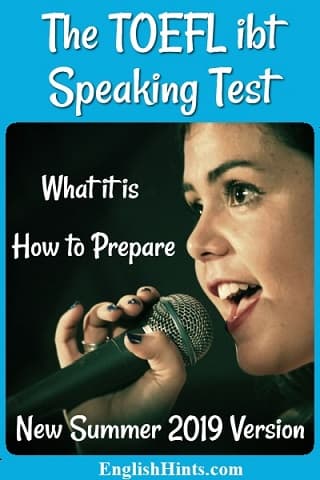Prepare for the TOEFL ibt Speaking Test
The TOEFL ibt Speaking Test can be an obstacle to your dreams. Here’s how it works and how to master it.
The New TOEFL Speaking Test
In August 2019 the TOEFL ibt speaking (and reading and listening) tests were shortened. They're a little simpler now, but still not easy!
You have 17 minutes to complete 4 speaking tasks. One is an independent speaking task and three are integrated tasks.
(Some of the preparation materials still refer to the 6 old tasks and task numbers.
Original questions 1 & 5 have been removed, and questions 2-4 have become 1-3. Old question 6 is now #4.
The up-to-date official information is here—with a link to an FAQ pdf with more answers.)
The ‘ibt’ in the test name means ‘internet-based test’. If you take your test at a location with internet access (like most test-takers), this is the test you’ll take.
You will read and listen to instructions (and background information for questions 2-4.) Then you will answer by speaking into a microphone. Your answers will be scored later by a specially trained team.
What Are the Current Speaking Test Question Types?
Question 1 (the independent task) asks your opinion about an issue and then for reasons why you feel that way. Be sure to give an example showing why you made that choice.
Remember that the examiners are not looking for a specific opinion. Instead, they want to see a clear explanation of why you chose that position. (In fact, you do not even have to give your actual feeling if it’s easier to explain a different choice. The most important step is to plan your response quickly with an example you can explain.)
Question 1 gives you 15 seconds to prepare and 45 seconds to speak. Notice the suggestions for this question on the link below.
In the integrated tasks (questions 2-4) you won’t give your opinion. You need to respond to a question based on what you have read and/or heard.)
Question 2 gives a reading passage and conversation related to a university campus issue.
You will have 45 seconds to read the article. Then you’ll listen to a conversation. (In the sample practice questions set you will read the conversation, but in the actual test you’ll listen to it.) You have 30 seconds to prepare a response and 60 seconds (a minute) to speak.
Be sure to answer the exact question asked, not just give general information about the article and conversation.
Question 3 asks you to respond to a specific question about an academic reading passage and a professor’s lecture on the same topic. The timing is the same as for question 2.
Question 4 is a question about a part of an academic lecture. (There’s no reading this time.) You have just 20 seconds to prepare a response, and again 60 seconds to speak.
It’s also worth studying the scoring rubrics for the Independent and the Integrated Speaking tasks. (The rubrics explain exactly what the examiners are looking for. They give you the criteria used to score your answer.) Each question receives a score from 0-4. Then the scores are combined and converted to a total TOEFL ibt Speaking score from 0-30.
"Practice Makes Perfect"
You should definitely also try the free practice test. (It’s for the whole TOEFL exam, though you could just try the speaking section, as I did this time.) ETS (the company that makes the TOEFL exam) lets you practice it as many times as you want.
The questions will still be the same, but you can get used to its organization, question types, and timing. The good news about the complete practice test is that it lets you practice with the new question types and times. (For the speaking test, that’s 4 speaking questions instead of 6).
I tried the speaking section of the free practice test. It’s difficult, even for a native English speaker, to have to prepare and answer so quickly.
(I found question 1 the hardest, because there is so little time to think about it before speaking. I would have gotten a low score because I could not think of more than two weak examples to support the opinion I had chosen.
I think I could do better after a lot more practice with this kind of question.) Lots of practice is essential before an actual test!
The other questions were easier for me. They might be for you as well if you are experienced at reading and listening in English. It’s essential to concentrate (focus) and to take quick basic notes, because you will not be able to review anything you read or heard.
Hints to Prepare for TOEFL ibt Speaking
- Practice speaking (& listening, & reading) all you can.
- Practice with English-speakers when possible (or other people who are studying English when it’s not.) Ask your listeners how easy it was to understand you and how complete your answer was.
- Practice answering the questions on the official TOEFL ibt speaking practice sets out loud, using a timer. Then compare your answer to the answer or suggestions they give in the practices.
- Remember to state your opinion clearly on question one and NOT to give your opinion on the other questions. (Questions 2-4 are designed to test how well you can explain what you have read and heard. Your opinion is not relevant.)
- Be sure to give examples with the necessary details to backup your response. The answers to the official practice questions give good examples of what they expect. (The TOEFL examiners realize you have limited time to speak, but you do need to include the most important details.)
- While practicing (and during the test), be sure to take brief notes about the reading passage and lecture to help you focus and to remember. Before answering, also write down a few words to help you organize your answer.
For general test-taking tips, see English Language Test Prep. It also has suggestions for preparing for your actual test day.
More Related Pages
Tips to help you prepare for the TOEFL Integrated Writing task.
English Essay writing practice to help you do well in classes and on essay tests like the TOEFL & IELTS Writing task 2.
Learn about the questions on the TOEFL Reading Section & a course that can help you master them.
Home> English Language Test Prep> TOEFL ibt Speaking Test
Didn't find what you
needed? Explain what you want in the search box below.
(For example, cognates, past tense practice, or 'get along with.') Click to see the related pages on EnglishHints.
| site search by freefind | advanced |









